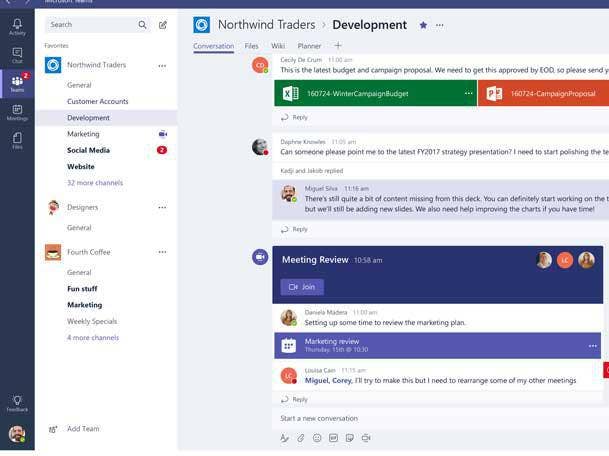5 Key Microsoft 365 Announcements At Build 2020
The Microsoft 365 platform is getting several updates around the Teams collaboration app, along with adding new capabilities for developing web-based apps and a new AI service.

One of the biggest changes in the Microsoft ecosystem since last year's Build developer conference is the emergence of Teams as a major force and focus.
At the digital-only Build 2020, which is kicking off today, Microsoft is unveiling a number of new capabilities for the Teams collaboration platform, which has surged in usage since the shift to work-from-home amid the COVID-19 pandemic. Teams has surpassed 75 million daily active users, Microsoft has said, more than doubling its user base from 32 million daily active users on March 11.
[Related: Microsoft Rebranding Office 365 Offerings For SMBs, ProPlus]
Build 2020 is also seeing other updates for the Microsoft 365 platform, which includes Windows 10, Office 365 apps (including Teams and Outlook), device management and security. Those include announcements about Microsoft's Fluid Framework (used for building web-based applications) and Project Cortex (a new AI service for Microsoft 365).
What follows are five key Microsoft 365 announcements at Build 2020.
Teams: Meetings And Events Updates
Microsoft is seeking to make it more convenient to schedule virtual appointments in Teams, using a new integration between Teams and Microsoft's Bookings app. A "single scheduling experience" will enable users to manage multiple locations and departments while allowing them to "securely host everything from candidate interviews and student office hours to financial consultations and medical visits," said Jared Spataro, corporate vice president for Microsoft 365, in a blog post Tuesday.
For hosting events with higher production values in Teams, Microsoft is rolling out new Network Device Interface support, as well as Skype TX interoperability. The Network Device Interface support enables users to achieve "professional broadcast capabilities" within Teams, while interoperability with Skype TX devices will enable 1:1 calls for newscasts in Teams to get professional-grade capabilities such as connection quality management and caller queuing, Spataro said.
Teams: Templates And Chatbots
Another expansion to Teams that is being unveiled at Build 2020 is the ability to choose customizable templates--including industry-specific templates such as bank brand or hospital ward, and typical business situations such as crisis response or event management.
The templates will each come with "pre-defined channels, apps, and guidance," and administrators will also be able to develop their own custom templates while bringing templates to existing teams--enabling them to "standardize team structures, surface relevant apps, and scale best practices," Spataro said. The templates capabilities for Teams will appear automatically, and will debut "in the next few months," according to Spataro.
Improve chatbot creation and management is also coming to Teams with the Power Virtual Agents app set to be offered in the Teams app store. Users will also be able to more easily integrate chatbots with Teams--simply by clicking "Add to Teams"--and Power Virtual Agents will now support single sign-on, as well.
Teams: Power Platform Integrations
Microsoft announced an upgrade to its Power Platform to provide easier integrations with Teams--enabling capabilities such as quickly adding automated workflows and custom apps in Teams.
Power Automate, which is Microsoft's automated workflow solution, has added Teams business process templates, the company said. Options include using pre-built templates or creating customized templates.
In terms of adding custom apps from Power Apps, admins and developers will "soon" have the ability to add the apps to Teams by clicking "Add to Teams" in Power Apps.
Fluid Framework
At last year's Build conference, Microsoft unveiled its Fluid Framework--new technology for building web-based distributed applications in a faster and more flexible manner.
The web-based platform enables content from the web and productivity apps to be deconstructed and reconstructed into modular components so that users can more easily build apps together. The framework went into public preview in November.
At Build 2020, Microsoft unveiled key updates to the Fluid Framework including the first integrations with Microsoft 365. The integrations "will enable you to collaborate on dynamic documents and create connected components that can be shared simultaneously and seamlessly across apps," Spataro said.
Developers can also use certain Fluid Framework infrastructure within their own applications for enabling real-time collaboration--such as data structures for performing synchronization with low latency, he said.
Additionally, "Microsoft will be making the Fluid Framework open source, allowing developers and creators to use key infrastructure from Fluid Framework in their own applications," Spataro said.
Project Cortex
Originally announced as a private preview in November, Project Cortex in Microsoft 365 is a new service that leverages AI to automatically classify all of an organization's content into topics. It ultimately forms a network of knowledge for users to tap for organizational intelligence and productivity.
Now, Microsoft is announcing general availability for Project Cortex starting in "early summer." Project Cortex is the first new service to join Microsoft 365 since Teams.
Microsoft is also unveiling a private preview at Build of developer APIs for Project Cortex and Managed Metadata Services in Microsoft Graph.